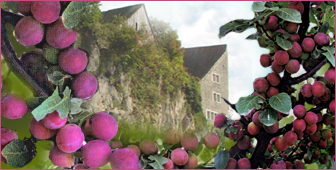In La Baroche, the rare damson ripens

The La Baroche region of canton Jura, known as the cradle of the damson - a plum-like fruit - is popular with cyclists and ramblers alike because of its rolling hills and steep rock faces. It's also a favourite of budding historians with some of the region's caves and relics dating back to the era of Celtic settlements.
A ring of six hamlets outline La Baroche: Miécourt, Pleujouse, Alle, Fregiécourt, Asuel and Charmoille.
During the first weeks of summer, just before the damassiniers (damson trees) begin to bear fruit, the scent of the trees’ characteristic white blossoms pervades the area, which is home to medieval castles, such as the Chateau Pleujouse, which once belonged to aristocratic families from France.
Most visitors begin their journey in Porrentruy and make their way to Alle, through Miécourt and the Rangiers pass, before finding the lush greenery of La Baroche, which sits to the east of Ajoie, where distilleries produce ‘damassine’ eau-de-vie.
Although there is no evidence to prove it, legend has it that French princes who fought in the Crusades brought the fruit back from the Middle East. Shakespeare referred to damsons in Act Two of his play, Henry the Sixth.
Damsons are about the same size as most plums but they tend to become dark red on one side – caused by exposure to the sun – and a golden yellow on the other. Damson trees are also rare in that they do not bear fruit every year, because of their innate hypersensitivity to moisture and surrounding temperatures.
Damson trees grow to approximately ten metres in height and their fruit is used to make the rare and expensive damassine eau-de-vie.
They also belong to the Prunus branch of the Rose family, and can sometimes live to over 100 years.
However, during the harvest season of late July to early August, the damson must never be picked, according to the secretary of the Association of Fruit Producers of Ajoie (APFA), Henri Jurot.
When the fruit falls
Jurot, who comes from a long line of small farmers, says picking the fruit affects its flavour when making damassine. This is why local farmers have to wait until the ripe damsons fall into nets, suspended like swings, from the branches of the trees, before they can gather them.
Damsons gathered during the first collection of the morning tend to be used more often in the production of damassine.
He added that farmers harvest ripe damsons almost as soon as the aroma of the falling fruit fills the hot air in the last weeks of July.
The harvest period invariably ends when autumnal mists descend on the hills of the La Baroche region, in August.
Jurot said the age of the trees also affects the quality of the damsons.”The trees whose plums give the best eau-de-vie are like vines: it is not the young plants which produce good wine”.
Delectable damassine
A delicious damassine can therefore only be distilled from the fruits of a tree that is over three years old. Unlike some other plums, damsons have a rather sweet juice, which makes it ideal for yeast-free methods of fermentation. However, the high content of sugar in its flesh makes it even more prone to fermenting in its own skin, if it is left too long in the harvest nets.
The high sugar content of ripe damsons is the main cause of its strong aroma, which wild animals and hunters can sense at a distance of up to 100 metres.
Jurot says damsons, which have ripened for too long in the sun can have a surprising effect.
“Every day, one has to gather up the fruits from the ground without ceasing or else, they will produce a hot caramel after being in the sun for too long, which can burn the fingers,” he says.
The extraction of the clear, dry damassine eau-de-vie begins with mashing ripe damsons.
Expensive taste
Every 100 litres of damson puree yields up to 10 litres of alcohol, which adds to the cost of the liqueur.
The fruit mash ferments for at least three weeks in barrels or casks , then is pumped into copper stills, and warmed. Vapours of alcohol rising from the warm, fermenting puree are further refined and cooled, to yield a better flavour.
“The people from our region who sell their damsons to make the authentic damassine can expect to earn around SFr80 to 90 per litre. Outside of the Jura region, that price can sharply increase to over SFr100,” says Alain Renzi whose family owns the Les Grandes-Vies SA distillery in Porrentruy.
As a rule of thumb Damassine generally costs double the price of the plums from which it is made.
by MaryAnn Mathew

In compliance with the JTI standards
More: SWI swissinfo.ch certified by the Journalism Trust Initiative









You can find an overview of ongoing debates with our journalists here . Please join us!
If you want to start a conversation about a topic raised in this article or want to report factual errors, email us at english@swissinfo.ch.